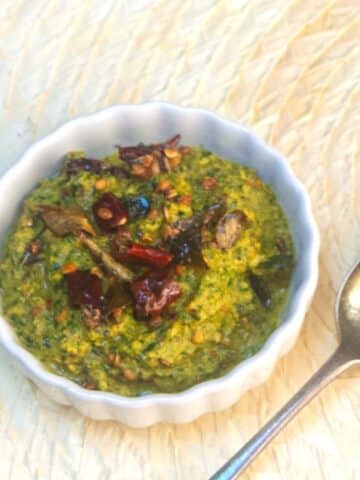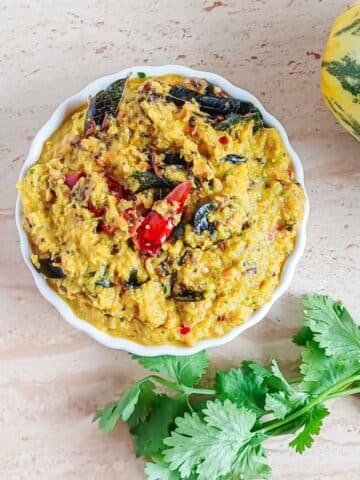Coconut Coriander Chutney - a popular south Indian condiment typically served with various dishes. This is a gluten-free, no onion no garlic chutney. Perfect to pair with most Indian breakfast dishes and crunchy deep fried snacks.

Due to its versatility and good taste, this south Indian chutney is the most popular food in Indian homes. It goes well with dosa, upma, pesarattu, idli, and vada.
This is a yogurt-based version of the typical coriander coconut chutney recipe. Instead of using tamarind, I used yogurt in this recipe, which lends a mild tanginess and keeps the chutney light colour rather than turning it bright green.

The subtle sweetness of coconut and a mild tangy taste and cream texture from yogurt make it delicious and adaptable to accompany multiple dishes. The tempering enhances the taste and flavour of chutney.
Jump to:
Why do we love this chutney?
Made with basic ingredients
No onion, no garlic recipe
Versatile chutney that goes well with many dishes
Gets ready in under 20 minutes
Ingredients

For Chutney
- Main Ingredients: Fresh coconut, green chillies, coriander leaves, curry leaves
- Spices: Cumin seeds and salt
- Dairy: Yogurt
- Liquid: Oil to saute all ingredients and water to grind chutney.
For Tadka
- Oil, mustard seeds, cumin seeds, urad dal, dried red chillies and curry leaves.
See the recipe card for quantities.
How to make peanut coconut chutney?

Heat oil in a small pan over medium heat.
Add green chillies and saute for a couple of minutes just until they release a strong aroma.

Now add curry leaves, diced fresh coconut, roasted gram dal, fresh coriander leaves, cumin and saute for 1-2 minutes.
Switch the heat off and let it cool completely.

Place the cooked ingredients in a blender or food processor.
Add salt, yogurt, and a little water and blend until you get a smooth paste.
If the chutney is too thick, you can add more water and blend again to get the desired consistency.
Transfer the coconut coriander chutney to a serving bowl.

For tadka, heat oil in the same pan.
Add mustard seeds, cumin seeds and urad dal. Allow them to splutter and the dal to turn golden brown.
Now add dried red chillies and curry leaves, and saute for a minute and then switch the heat off.
Pour the tempering over the chutney and mix well.

Serve the chutney with any dish of your choice.
Substitutions and Variations
Coconut: Fresh coconut provides the best flavour and taste. But desiccated coconut or frozen coconut can be used instead. Adjust the quantity accordingly.
Yogurt: Use either homemade or store bought yogurt but make sure it is fresh. Ensure it is well within its expiry date if using store-bought yogurt. Too sour yogurt will ruin the taste of the chutney. So taste it before adding in a mixer jar.
Green Chilies: Depending on your preferred level of spice, replace them with jalapeños or any other fresh green chilli pepper.
Serving Suggestions
Serve the green coconut chutney alongside any South Indian food, such as dosa, idli, medu vada, rava paddu, pesarattu, and upma. It can also be used as a tasty condiment to enhance other foods.
Pair it as a side dish with deep-fried appetisers like vegetable pakoda, bonda, vada, and cabbage pakoda.

Storage
Fridge: Store any leftover chutney in an airtight container in the fridge. It stays good for two to three days.
Before serving, remove the chutney from the refrigerator and allow it to sit on the platform for an hour to lose its chillness.
Tips and Tricks
Ingredient Sauteing: Before grinding, it's necessary to saute the coconut, chilies, roasted gram, and other ingredients. This improves the chutney's flavour and taste while eliminating the raw aroma.
Adjust Spice Levels: Green chilies add heat to the chutney. Add extra or reduce the number of chillies based on your spice tolerance. Remove seeds for a milder taste.
Consistency: Vary the thickness of the chutney by adjusting the water added while blending. Use less water to make the chutney thicker; add more water gradually to make it thinner.
Tempering at the Right Temperature: Heat the oil to temper sufficiently but avoid overheating to prevent burning the spices.
Tempering Sequence: Add mustard seeds, cumin, urad dal first; once they splutter, add red chillies and finally, curry leaves. This sequence ensures the flavours are released effectively.
FAQ
I wouldn't suggest freezing this chutney.
To make a vegan version, replace dairy yogurt with coconut yogurt. Taste the chutney and adjust the quantity to suit your taste. Not every brand of coconut yogurt has same level of sourness.
KEEP IN TOUCH
Do let me know if you try this simple south Indian style coriander coconut chutney recipe. If you like this recipe kindly consider rating it using stars in the comment section or on the recipe card to help more people find this recipe online. You can stay up to date by following me on Facebook, Pinterest, Instagram or subscribing to my Youtube channel. Or why not subscribe to my blog and get simple recipes straight to your inbox?
📖 Recipe Card

South Indian Coconut Coriander Chutney
Ingredients
1 Cup = 250ml ; 1 Tablespoon = 15ml ; 1 Teaspoon = 5ml
For Chutney
- 1 Tablespoon Oil
- 6 Green Chillies adjust to yourspice levels
- 1 sprig Curry Leaves remove leaves from stem
- 150 gms (or) 1 cup Fresh Coconut remove from shell and chop roughly
- 40 gms Fried Gram
- 1 Teaspoon Cumin Seeds
- Half bunch Fresh Coriander Leaves
- Yogurt
- Salt
For Tadka
- 1 Teaspoon Oil
- ½ Teaspoon Mustard Seeds
- ½ Teaspoon Cumin Seeds
- 1 Teaspoon Urad Dal
- 3 small Dried Red Chillies
- 1 sprig Curry Leaves remove the leaves from the stem
Instructions
- Heat oil in a small pan over medium heat.1 Tablespoon Oil
- Add green chillies and saute for a couple of minutes just until they release a strong aroma.6 Green Chillies
- Now add curry leaves, diced fresh coconut, roasted gram dal, fresh coriander leaves, cumin and saute for 1-2 minutes.1 sprig Curry Leaves, 150 gms (or) 1 cup Fresh Coconut, 40 gms Fried Gram, 1 Teaspoon Cumin Seeds, Half bunch Fresh Coriander Leaves
- Switch the heat off and let it cool completely.
- Place the cooked ingredients in a blender or food processor.
- Add salt, yogurt, and a little water and blend until you get a smooth paste.Yogurt, Salt
- If the chutney is too thick, you can add more water and blend again to get the desired consistency.
- Transfer the coconut coriander chutney to a serving bowl.
- For tadka, heat oil in the same pan.1 Teaspoon Oil
- Add mustard seeds, cumin seeds and urad dal.½ Teaspoon Mustard Seeds, ½ Teaspoon Cumin Seeds, 1 Teaspoon Urad Dal
- Allow them to splutter and the dal to turn golden brown.
- Now add dried red chillies and curry leaves, and saute for a minute and then switch the heat off.3 small Dried Red Chillies, 1 sprig Curry Leaves
- Pour the tempering over the blended chutney and mix well.
- Serve the chutney with idli dosa, vada, or any South Indian snacks of your choice.
Notes
Nutrition
Related
Looking for other south Indian recipes? Try these:

Welcome to Flavours Treat. I share vegetarian recipes made with wholesome, mostly fresh ingredients. Every recipe has easy-to-follow instructions with process shots (detailed step-wise pictures), a short video and lots of tips to help your cooking journey. Read more










Leave a Reply